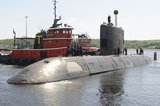First China-made aircraft carrier starts sea trials
China's first domestically manufactured aircraft carrier started sea trials on 13 May, state media said, a landmark in Beijing's plans to modernise its navy as it presses its claims in disputed regional waters.
The carrier, known only as Type 001A, set out for the trials from a port in northeastern China at around 6.45am, according to state broadcaster CCTV.
Expected to be commissioned by 2020, the ship will give China a second aircraft carrier as it asserts its claims in the South China Sea and seeks to deter any independence movements in Taiwan.
Footage aired by CCTV showed the imposing carrier accompanied by several smaller military craft leaving a wharf and heading out to sea.
It is the first time the ship's engine, propulsion and navigation systems will be tested at sea, state media said, a year after it first took to the water at its official launch.
China's sole operational aircraft carrier, the Liaoning, is a repurposed Soviet ship bought from Ukraine, which went into service in 2012.
Neither the Liaoning nor the new ship are nuclear powered, but both can carry around 40 planes and have similar ski jump ramps, an old launch system that forces aircraft to carry fewer weapons in order to hold more fuel for take-off.
The possession of a homegrown aircraft carrier - which the defence ministry has said displaces 55,000t - places China among the few military powers with such vessels, including the United States, Russia and Britain.
But it would still be no match in size or range to the nuclear powered vessels of the US Navy, which has 11 carriers.
China's warships will enable it to 'project its power and influence in its neighbourhood', Steve Tsang, director of the China Institute at London's School of Oriental and African Studies (SOAS), told AFP.
Chinese state media have been speculating that a third aircraft carrier is in the works, but the defence ministry has yet to confirm this.
However, even with the potential development of further carriers, it could still be years before China's navy is able to deploy its fleet effectively, said Tsang.
'With the Chinese carriers substantially inferior in capacity to the US super-carriers, the balance of forces between the two navies will only change marginally rather than substantially,' he said.
Beijing has embarked on an extensive project to build a blue water navy and modernise its two million-strong military, the world's largest.
China's defence budget rose 8.1% to 1.1 trillion yuan ($175 billion) in 2018, but it is still only about a quarter that of the US.
The Liaoning has conducted a series of manoeuvres with dozens of other ships, submarines and aircraft in the South China Sea in recent weeks.
In March it sailed through the Taiwan Strait, prompting Taipei to dispatch ships and planes to track the vessel, on the same day Chinese President Xi Jinping warned against what he called any attempts to split China.
Beijing sees democratically governed Taiwan as a renegade part of its territory to be brought back into the fold and has not ruled out reunification by force.
China, Brunei, Malaysia, the Philippines, Vietnam and Taiwan have claims to the South China Sea, while Beijing also has territorial disputes with Japan in the East China Sea.
The US, meanwhile, regularly conducts freedom of navigation naval operations near artificial islands in the South China Sea to challenges Beijing's claims.
More from Naval Warfare
-
![Is the US Navy’s Golden Fleet initiative achievable?]()
Is the US Navy’s Golden Fleet initiative achievable?
The effort to provide the US Navy with Trump-class battleships might face financial, production and doctrinal obstacles.
-
![Will the US Navy surge production for OTH-WS missile?]()
Will the US Navy surge production for OTH-WS missile?
The USN is conducting a market search seeking additional sources capable of supplying 516 units of Over the Horizon – Weapons System Encanistered Missiles.
-
![Maritime defence in the Mediterranean faces challenges from vulnerable land power]()
Maritime defence in the Mediterranean faces challenges from vulnerable land power
As an indispensable energy crossroads, the Mediterranean is at serious risk from grey zone disruption. As navies increasingly employ AI data centres, what happens when cutting-edge defence technologies rely on the very infrastructure most susceptible to hybrid tactics?
-
![US Navy to conduct an experimentation campaign with emerging tech in 2026 and 2027]()
US Navy to conduct an experimentation campaign with emerging tech in 2026 and 2027
The Technology Operational Experimentation Events will inform future requirements as the US Navy looks for innovative solutions across three key operational domains.






















